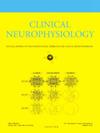Force control deficits in rapid eye movement behavior disorder and Parkinson’s disease
IF 3.7
3区 医学
Q1 CLINICAL NEUROLOGY
引用次数: 0
Abstract
Objective
This study aimed to determine if there are deficits in force variability, force increase, force decrease and force errors in rapid eye movement behavior disorder (RBD) using established force control paradigms.
Methods
A cohort of 27 controls, 37 RBD and 37 early-stage Parkinson’s disease (PD) were investigated. Individuals completed constant force and ballistic force control for the finger and ankle.
Results
There was greater force variability in RBD compared with controls and PD during the constant force tasks (p < 0.05). Additionally, we split the RBD group into those with mild and moderate motor impairments and found both groups had higher force variability compared with controls (p < 0.05). PD were slower at increasing and decreasing force (p < 0.05) and this was not observed in the RBD group.
Conclusion
These findings provide new evidence that force variability may be one of the earliest markers of motor dysfunction in RBD before a subsequent diagnosis of neurological disease.
Significance
These findings provide new and important insights into the motor physiological changes in force control in RBD and PD, which may inform future biomarker studies.
快速眼动行为障碍和帕金森病的力控制缺陷
目的利用已建立的力控制范式,探讨快速眼动行为障碍(RBD)患者在力变异性、力增加、力减少和力错误方面是否存在缺陷。方法对对照27例、RBD 37例、早期帕金森病37例进行队列研究。个人完成了手指和脚踝的恒定力和弹道力控制。结果与对照组和PD相比,RBD患者在恒力任务中存在更大的力变异性(p <;0.05)。此外,我们将RBD组分为轻度和中度运动障碍组,发现两组与对照组相比都有更高的力量变异性(p <;0.05)。PD在增加和减少力时较慢(p <;0.05),而RBD组没有观察到这一点。结论这些发现提供了新的证据,表明力量变异性可能是RBD患者在随后的神经系统疾病诊断之前运动功能障碍的最早标志之一。这些发现为RBD和PD中力量控制的运动生理变化提供了新的重要见解,可能为未来的生物标志物研究提供信息。
本文章由计算机程序翻译,如有差异,请以英文原文为准。
求助全文
约1分钟内获得全文
求助全文
来源期刊

Clinical Neurophysiology
医学-临床神经学
CiteScore
8.70
自引率
6.40%
发文量
932
审稿时长
59 days
期刊介绍:
As of January 1999, The journal Electroencephalography and Clinical Neurophysiology, and its two sections Electromyography and Motor Control and Evoked Potentials have amalgamated to become this journal - Clinical Neurophysiology.
Clinical Neurophysiology is the official journal of the International Federation of Clinical Neurophysiology, the Brazilian Society of Clinical Neurophysiology, the Czech Society of Clinical Neurophysiology, the Italian Clinical Neurophysiology Society and the International Society of Intraoperative Neurophysiology.The journal is dedicated to fostering research and disseminating information on all aspects of both normal and abnormal functioning of the nervous system. The key aim of the publication is to disseminate scholarly reports on the pathophysiology underlying diseases of the central and peripheral nervous system of human patients. Clinical trials that use neurophysiological measures to document change are encouraged, as are manuscripts reporting data on integrated neuroimaging of central nervous function including, but not limited to, functional MRI, MEG, EEG, PET and other neuroimaging modalities.
 求助内容:
求助内容: 应助结果提醒方式:
应助结果提醒方式:


